GMBA8102: Mental Health and Resilience Discussion Forum Contribution
VerifiedAdded on 2022/08/12
|5
|1122
|29
Discussion Board Post
AI Summary
This discussion forum post reflects on the student's learning journey in a course focused on building personal resilience, particularly concerning workplace stress. The assignment involved weekly forum contributions and a summary analysis. The student discusses the impact of workplace environment on stress, referencing a peer's post about a clutter-free work environment. They also explore the importance of physical and mental fitness, time management, and finding meaning in work as key resilience strategies, drawing on insights from other peer posts and relevant research. The student highlights the practical applications of these strategies, such as incorporating exercise and prioritizing tasks, to manage stress and enhance overall well-being and motivation. The assignment showcases the student's understanding of stress management techniques and their ability to reflect on and integrate these concepts into their personal approach to handling workplace stressors.
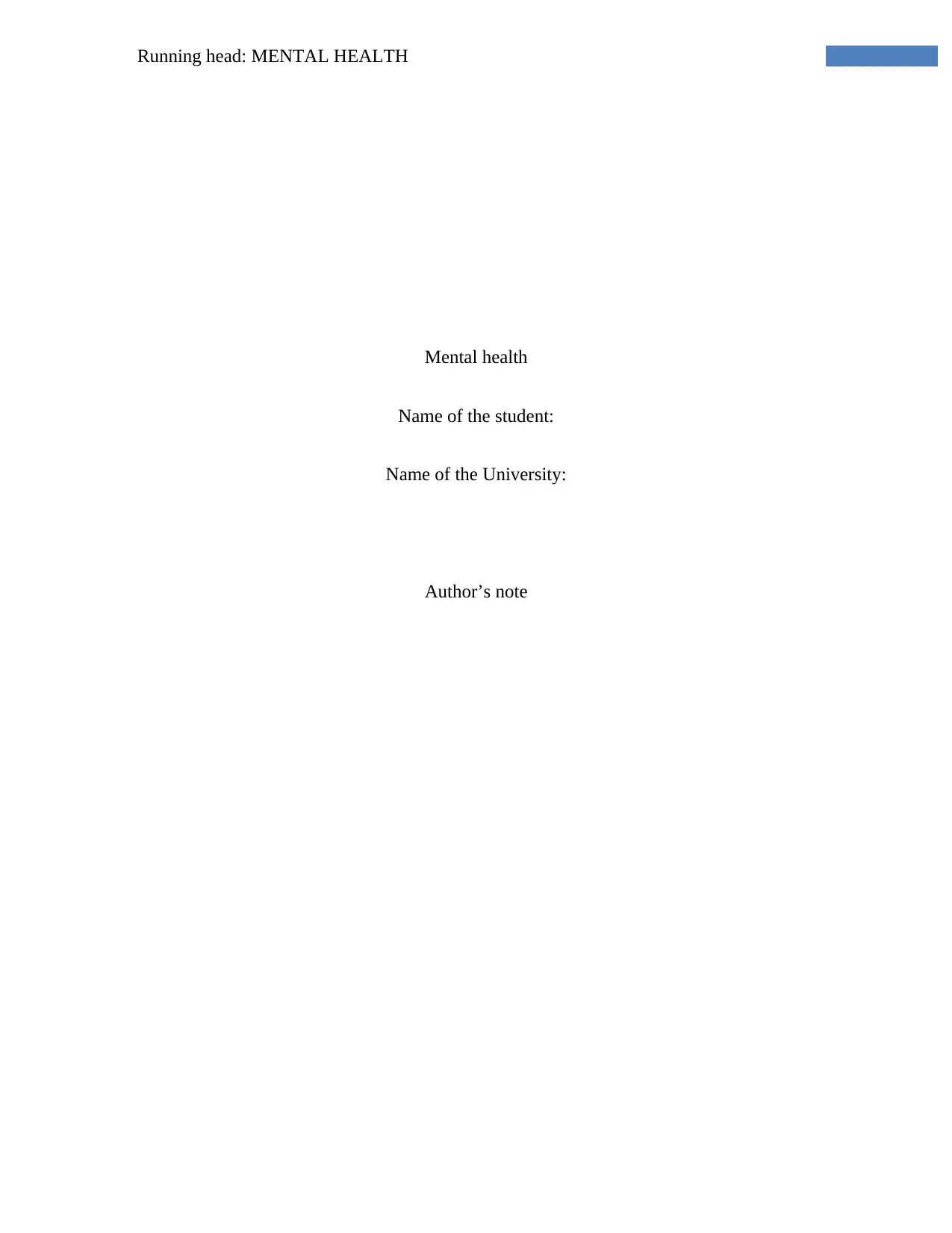
Running head: MENTAL HEALTH
Mental health
Name of the student:
Name of the University:
Author’s note
Mental health
Name of the student:
Name of the University:
Author’s note
Paraphrase This Document
Need a fresh take? Get an instant paraphrase of this document with our AI Paraphraser
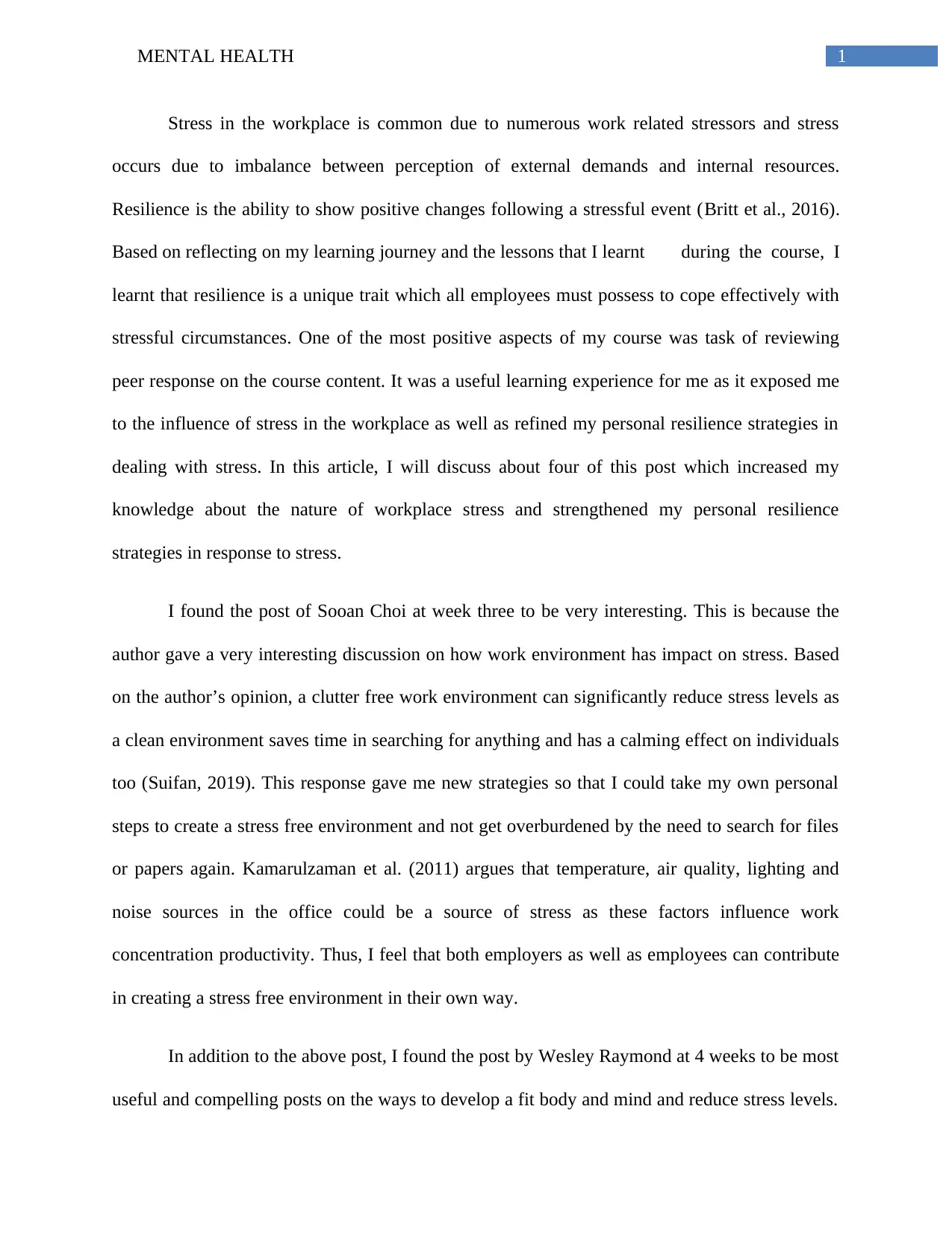
1MENTAL HEALTH
Stress in the workplace is common due to numerous work related stressors and stress
occurs due to imbalance between perception of external demands and internal resources.
Resilience is the ability to show positive changes following a stressful event (Britt et al., 2016).
Based on reflecting on my learning journey and the lessons that I learnt during the course, I
learnt that resilience is a unique trait which all employees must possess to cope effectively with
stressful circumstances. One of the most positive aspects of my course was task of reviewing
peer response on the course content. It was a useful learning experience for me as it exposed me
to the influence of stress in the workplace as well as refined my personal resilience strategies in
dealing with stress. In this article, I will discuss about four of this post which increased my
knowledge about the nature of workplace stress and strengthened my personal resilience
strategies in response to stress.
I found the post of Sooan Choi at week three to be very interesting. This is because the
author gave a very interesting discussion on how work environment has impact on stress. Based
on the author’s opinion, a clutter free work environment can significantly reduce stress levels as
a clean environment saves time in searching for anything and has a calming effect on individuals
too (Suifan, 2019). This response gave me new strategies so that I could take my own personal
steps to create a stress free environment and not get overburdened by the need to search for files
or papers again. Kamarulzaman et al. (2011) argues that temperature, air quality, lighting and
noise sources in the office could be a source of stress as these factors influence work
concentration productivity. Thus, I feel that both employers as well as employees can contribute
in creating a stress free environment in their own way.
In addition to the above post, I found the post by Wesley Raymond at 4 weeks to be most
useful and compelling posts on the ways to develop a fit body and mind and reduce stress levels.
Stress in the workplace is common due to numerous work related stressors and stress
occurs due to imbalance between perception of external demands and internal resources.
Resilience is the ability to show positive changes following a stressful event (Britt et al., 2016).
Based on reflecting on my learning journey and the lessons that I learnt during the course, I
learnt that resilience is a unique trait which all employees must possess to cope effectively with
stressful circumstances. One of the most positive aspects of my course was task of reviewing
peer response on the course content. It was a useful learning experience for me as it exposed me
to the influence of stress in the workplace as well as refined my personal resilience strategies in
dealing with stress. In this article, I will discuss about four of this post which increased my
knowledge about the nature of workplace stress and strengthened my personal resilience
strategies in response to stress.
I found the post of Sooan Choi at week three to be very interesting. This is because the
author gave a very interesting discussion on how work environment has impact on stress. Based
on the author’s opinion, a clutter free work environment can significantly reduce stress levels as
a clean environment saves time in searching for anything and has a calming effect on individuals
too (Suifan, 2019). This response gave me new strategies so that I could take my own personal
steps to create a stress free environment and not get overburdened by the need to search for files
or papers again. Kamarulzaman et al. (2011) argues that temperature, air quality, lighting and
noise sources in the office could be a source of stress as these factors influence work
concentration productivity. Thus, I feel that both employers as well as employees can contribute
in creating a stress free environment in their own way.
In addition to the above post, I found the post by Wesley Raymond at 4 weeks to be most
useful and compelling posts on the ways to develop a fit body and mind and reduce stress levels.
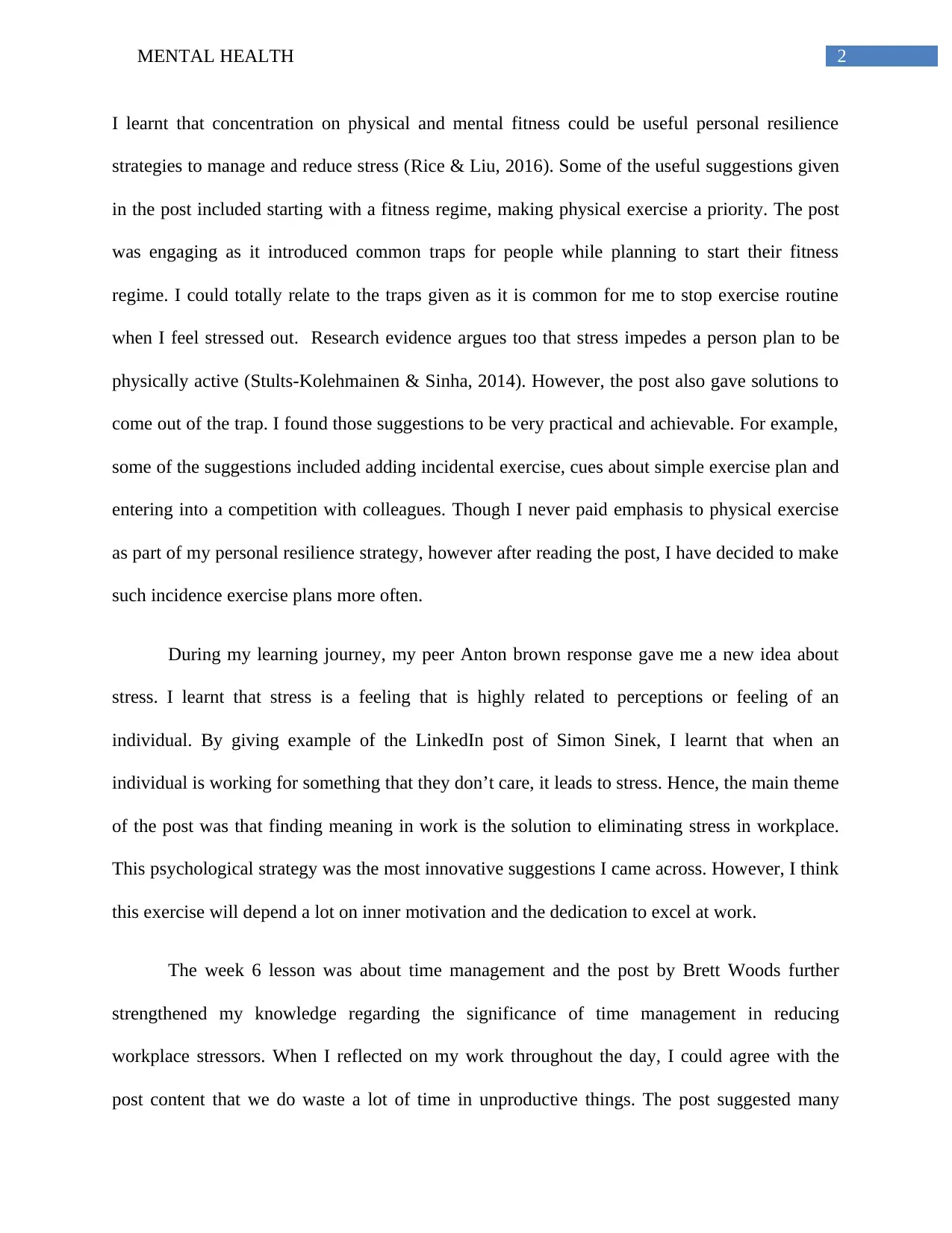
2MENTAL HEALTH
I learnt that concentration on physical and mental fitness could be useful personal resilience
strategies to manage and reduce stress (Rice & Liu, 2016). Some of the useful suggestions given
in the post included starting with a fitness regime, making physical exercise a priority. The post
was engaging as it introduced common traps for people while planning to start their fitness
regime. I could totally relate to the traps given as it is common for me to stop exercise routine
when I feel stressed out. Research evidence argues too that stress impedes a person plan to be
physically active (Stults-Kolehmainen & Sinha, 2014). However, the post also gave solutions to
come out of the trap. I found those suggestions to be very practical and achievable. For example,
some of the suggestions included adding incidental exercise, cues about simple exercise plan and
entering into a competition with colleagues. Though I never paid emphasis to physical exercise
as part of my personal resilience strategy, however after reading the post, I have decided to make
such incidence exercise plans more often.
During my learning journey, my peer Anton brown response gave me a new idea about
stress. I learnt that stress is a feeling that is highly related to perceptions or feeling of an
individual. By giving example of the LinkedIn post of Simon Sinek, I learnt that when an
individual is working for something that they don’t care, it leads to stress. Hence, the main theme
of the post was that finding meaning in work is the solution to eliminating stress in workplace.
This psychological strategy was the most innovative suggestions I came across. However, I think
this exercise will depend a lot on inner motivation and the dedication to excel at work.
The week 6 lesson was about time management and the post by Brett Woods further
strengthened my knowledge regarding the significance of time management in reducing
workplace stressors. When I reflected on my work throughout the day, I could agree with the
post content that we do waste a lot of time in unproductive things. The post suggested many
I learnt that concentration on physical and mental fitness could be useful personal resilience
strategies to manage and reduce stress (Rice & Liu, 2016). Some of the useful suggestions given
in the post included starting with a fitness regime, making physical exercise a priority. The post
was engaging as it introduced common traps for people while planning to start their fitness
regime. I could totally relate to the traps given as it is common for me to stop exercise routine
when I feel stressed out. Research evidence argues too that stress impedes a person plan to be
physically active (Stults-Kolehmainen & Sinha, 2014). However, the post also gave solutions to
come out of the trap. I found those suggestions to be very practical and achievable. For example,
some of the suggestions included adding incidental exercise, cues about simple exercise plan and
entering into a competition with colleagues. Though I never paid emphasis to physical exercise
as part of my personal resilience strategy, however after reading the post, I have decided to make
such incidence exercise plans more often.
During my learning journey, my peer Anton brown response gave me a new idea about
stress. I learnt that stress is a feeling that is highly related to perceptions or feeling of an
individual. By giving example of the LinkedIn post of Simon Sinek, I learnt that when an
individual is working for something that they don’t care, it leads to stress. Hence, the main theme
of the post was that finding meaning in work is the solution to eliminating stress in workplace.
This psychological strategy was the most innovative suggestions I came across. However, I think
this exercise will depend a lot on inner motivation and the dedication to excel at work.
The week 6 lesson was about time management and the post by Brett Woods further
strengthened my knowledge regarding the significance of time management in reducing
workplace stressors. When I reflected on my work throughout the day, I could agree with the
post content that we do waste a lot of time in unproductive things. The post suggested many
⊘ This is a preview!⊘
Do you want full access?
Subscribe today to unlock all pages.

Trusted by 1+ million students worldwide
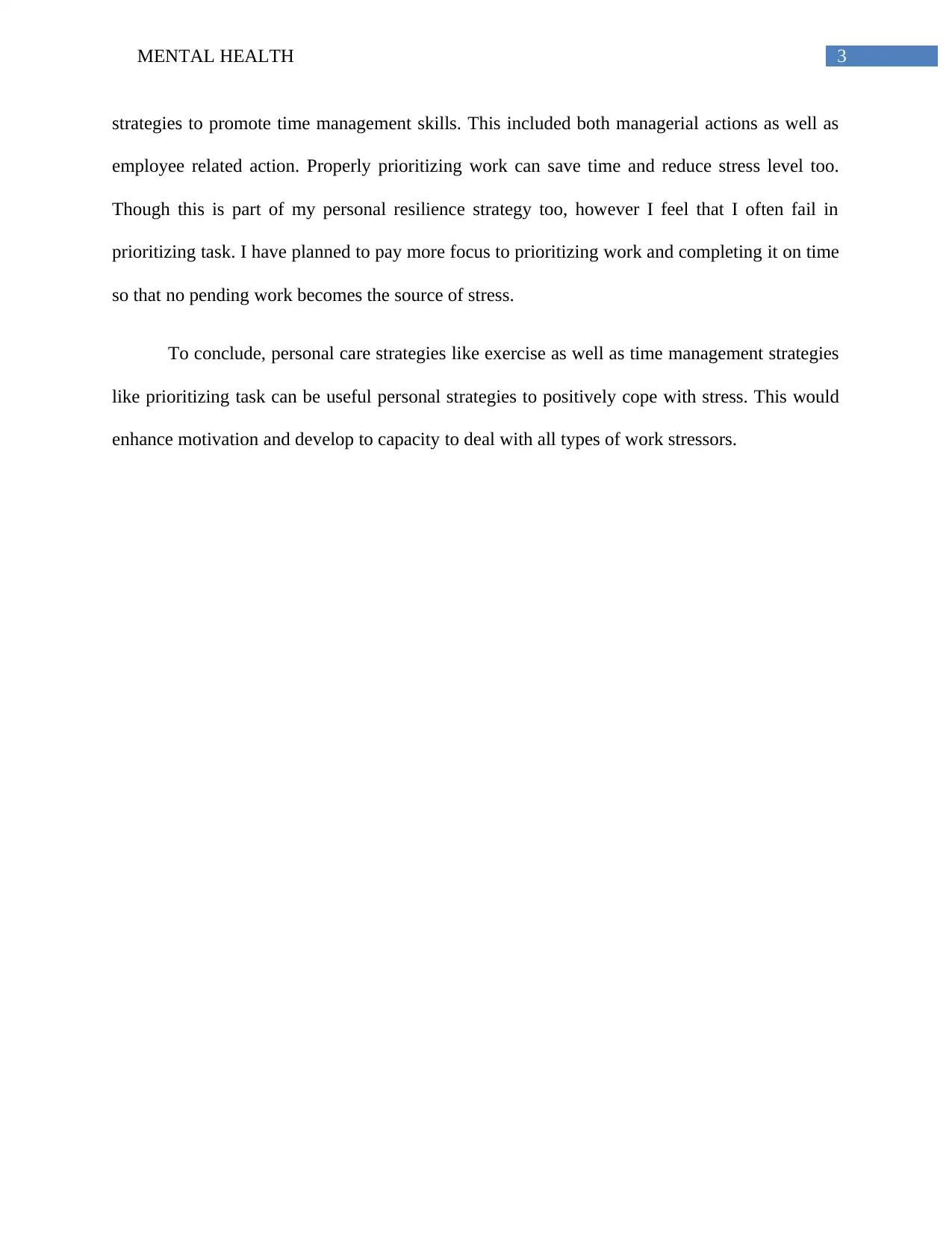
3MENTAL HEALTH
strategies to promote time management skills. This included both managerial actions as well as
employee related action. Properly prioritizing work can save time and reduce stress level too.
Though this is part of my personal resilience strategy too, however I feel that I often fail in
prioritizing task. I have planned to pay more focus to prioritizing work and completing it on time
so that no pending work becomes the source of stress.
To conclude, personal care strategies like exercise as well as time management strategies
like prioritizing task can be useful personal strategies to positively cope with stress. This would
enhance motivation and develop to capacity to deal with all types of work stressors.
strategies to promote time management skills. This included both managerial actions as well as
employee related action. Properly prioritizing work can save time and reduce stress level too.
Though this is part of my personal resilience strategy too, however I feel that I often fail in
prioritizing task. I have planned to pay more focus to prioritizing work and completing it on time
so that no pending work becomes the source of stress.
To conclude, personal care strategies like exercise as well as time management strategies
like prioritizing task can be useful personal strategies to positively cope with stress. This would
enhance motivation and develop to capacity to deal with all types of work stressors.
Paraphrase This Document
Need a fresh take? Get an instant paraphrase of this document with our AI Paraphraser
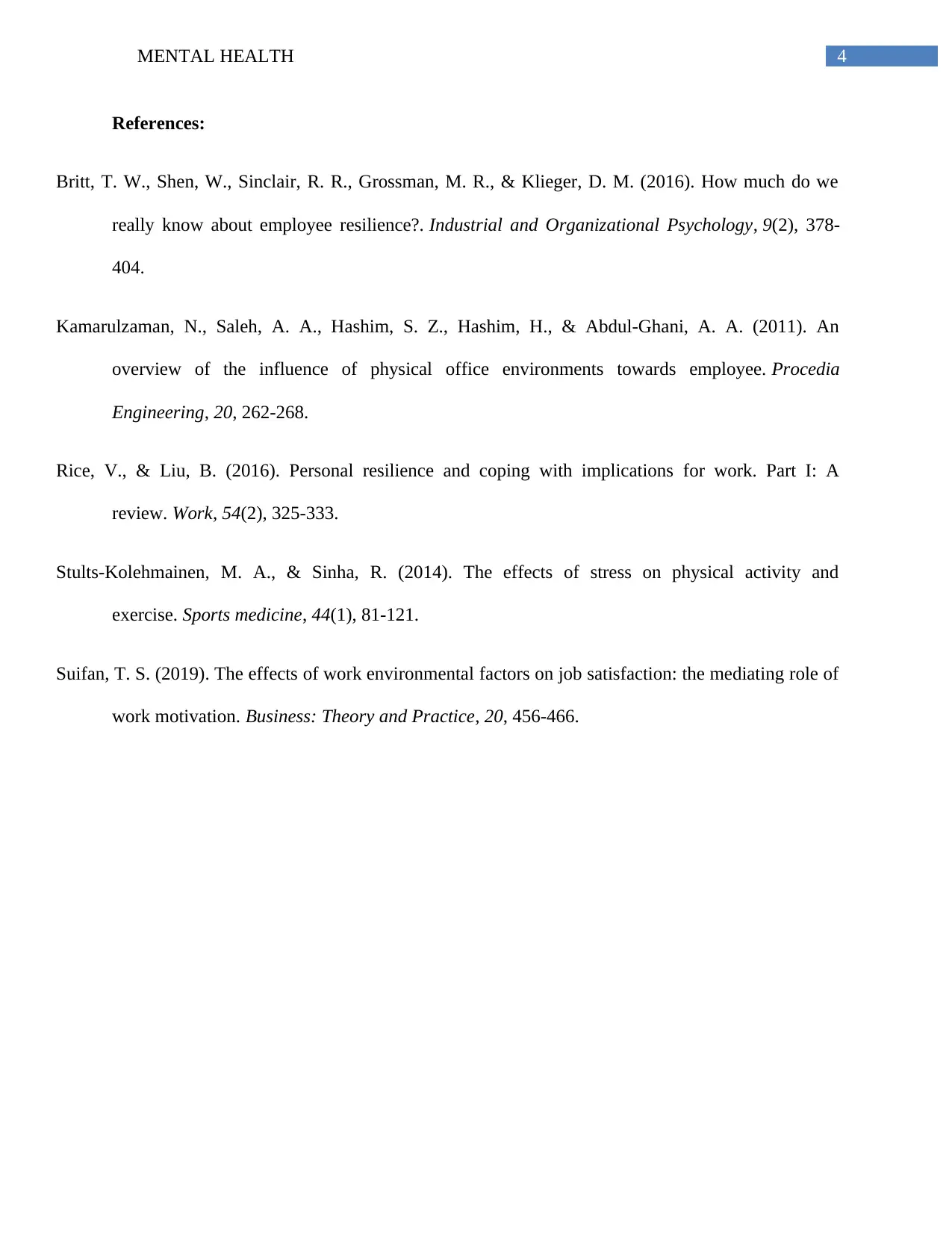
4MENTAL HEALTH
References:
Britt, T. W., Shen, W., Sinclair, R. R., Grossman, M. R., & Klieger, D. M. (2016). How much do we
really know about employee resilience?. Industrial and Organizational Psychology, 9(2), 378-
404.
Kamarulzaman, N., Saleh, A. A., Hashim, S. Z., Hashim, H., & Abdul-Ghani, A. A. (2011). An
overview of the influence of physical office environments towards employee. Procedia
Engineering, 20, 262-268.
Rice, V., & Liu, B. (2016). Personal resilience and coping with implications for work. Part I: A
review. Work, 54(2), 325-333.
Stults-Kolehmainen, M. A., & Sinha, R. (2014). The effects of stress on physical activity and
exercise. Sports medicine, 44(1), 81-121.
Suifan, T. S. (2019). The effects of work environmental factors on job satisfaction: the mediating role of
work motivation. Business: Theory and Practice, 20, 456-466.
References:
Britt, T. W., Shen, W., Sinclair, R. R., Grossman, M. R., & Klieger, D. M. (2016). How much do we
really know about employee resilience?. Industrial and Organizational Psychology, 9(2), 378-
404.
Kamarulzaman, N., Saleh, A. A., Hashim, S. Z., Hashim, H., & Abdul-Ghani, A. A. (2011). An
overview of the influence of physical office environments towards employee. Procedia
Engineering, 20, 262-268.
Rice, V., & Liu, B. (2016). Personal resilience and coping with implications for work. Part I: A
review. Work, 54(2), 325-333.
Stults-Kolehmainen, M. A., & Sinha, R. (2014). The effects of stress on physical activity and
exercise. Sports medicine, 44(1), 81-121.
Suifan, T. S. (2019). The effects of work environmental factors on job satisfaction: the mediating role of
work motivation. Business: Theory and Practice, 20, 456-466.
1 out of 5
Related Documents
Your All-in-One AI-Powered Toolkit for Academic Success.
+13062052269
info@desklib.com
Available 24*7 on WhatsApp / Email
![[object Object]](/_next/static/media/star-bottom.7253800d.svg)
Unlock your academic potential
Copyright © 2020–2025 A2Z Services. All Rights Reserved. Developed and managed by ZUCOL.





